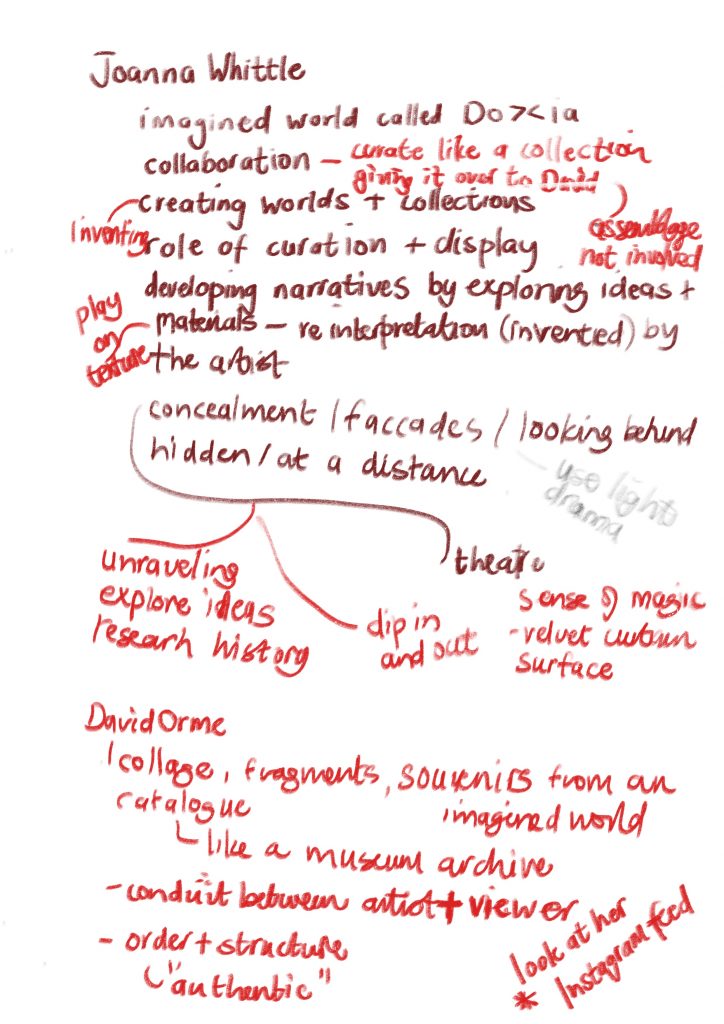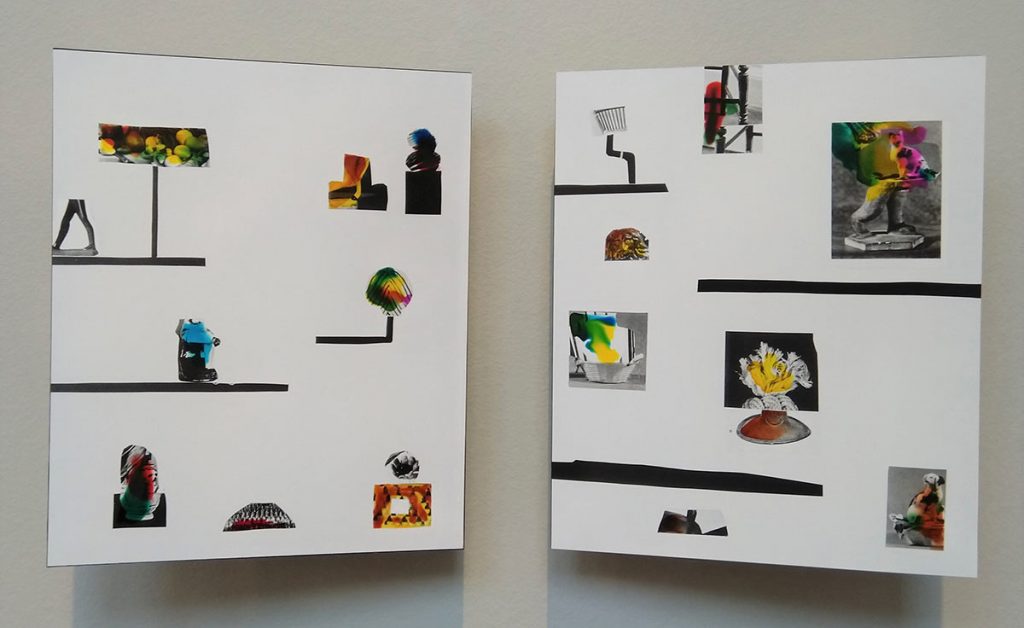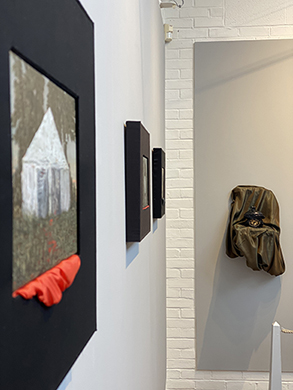Zoom workshop on Between Islands, a current exhibition at the Harley Gallery

Research and preparation for the planned Zoom workshop on Wednesday 30 Sept 2020
The artist has collaborated with artist, David Orme in this exhibition which consists of paintings, drawings and ceramics.
The artists intention as on her website:
“I will be working with the Portland Collection at the Harley Gallery in Worksop. I will be creating paintings, ceramics and prints inspired by the collection and the surrounding landscape of the Harley Gallery and Wellbeck Abbey. This project will culminate in a final exhibition…”
The project has involved collaboration with artist David Orme, to explore the determinations of display and the decisions made to formalise the fictional into the authentic. The exhibition is in the form of a curated display around collections of artifacts from an imagined world, called Do><ia. I looked at the Portland Display and in many ways this exhibition echos the curation, but the difference is the imagined which is explored in this case. Joanna Wittle invited/’allowed’ David Orme to do the display, as he likes order and structure and he sees himself as the conduit between the her as the artist and the viewer. His own work is collaged work, also displayed as fragments of souvenirs from the artists imagined world and displayed in a catalogue way on the walls, to add to the idea of a museum archive of collections.
One gets the idea of an immense landscape of the Wellbeck Estate, of hidden tunnels, pre historical caves, an abbey and the artefacts of the 17th century Portland collection itself. She uses the paintings to bring in the landscape, where she focus on the “hidden’ – like the concealed tunnel. It is important to bring in the framing of these paintings, as they play on textures and concealment as well as add to a form of theatrical feel and scale to her small sized paintings – “extending it in a strange way,” is how she describes it in the video. It is clear that by looking at her paintings one will find layer of meaning unraveling. It is as if the use of fabric as frames keeps the work in the different world the artist intended. The artist uses ‘incidental encounters when she starts exploring subjects, let it unravel and create a narrative in her own ‘made up world of ideas’. It is clear that one can get distracted as there are so many things, you need focus – can’t be ‘seduced’ by everything. She talks about dipping in and out, use history (truth? ) but not too much – the work could become illustrative and the information can numb you. This brings me to her own created world – she calls Do><ia, which is an acronym for ‘a void‘. This was a period when she went through a period of creative block an used this experience to change her way of research and making – an island mythology using diaries of drawing and maps The artist is aware of the book, The Description of a New World called The Blazing World, written by Margaret Cavendish and refers to this within the work. Thinking about the body of work and how a viewer would interact – the work is dismantling authenticity and value from an artifact position – the artist conceals this with her display of the work, by ‘representing’ them as artifacts. She actually in her work process creates new meanings to the original artifacts. as well as landscapes. I also wonder if she tries to say that artistic intent is not static?
It becomes clear to me that the islands in the name of the exhibition refers to the illusory aspects within the work and the collection that exists with which it both engages and undermines reality. I do like this ideas in her work.
On a OCA site, In Conversation with Joanna Whittle, (17/09/2019) se talks about her work being small: “...as things become smaller illusionary language becomes more intensified whilst moments of plasticity are reduced. By which I mean, the painting surface becomes less solid- the viewer peers in and the world opens up like a hallucination – the weight of the paint falls away. It’s plasticity, its three dimensional pigmented form become less stable. Yet equivalently – as a painter, as someone who has chosen to use this three dimensional substance, I am interested in the tension that exists between the material and the illusion and the moments where this is intensified and the viewer is drawn back to the painted surface.” and the following I feel is important about how she paints:
Tell me a little about the mechanics of the paintings you make.
The paintings are made using traditional oil painting techniques of indirect painting – i.e. multiple layers of translucent and semi opaque layers combine to make the final image. I find that, for my purposes, this gives depth and enhances illusionary qualities whilst undermining the flat surface of the painting- making its reinstatement through more direct painting more compelling. Preparing the surface before painting becomes very important in this dialogue and I often feel this aspect of painting is overlooked or rushed- but the ground holds the whole basis of the painting. Paying attention to the surface one paints on and its preparation underpins the whole work.

Above is the virtual discussion I could view as shown on the gallery’s website.
Joanna: There are indeed implied narratives in my paintings, but these always seem elusive and not fully formed – made up of many elements which often conflict and unsettle any stable narrative. I think that’s what really appeals to me about working with the Welbeck Estate and Portland collection, there are so many different histories and narratives, each seeming to remain half concealed and ambiguous. To some extent it is the aspect of deciphering evidence and artefacts of these histories which I find fascinating and which cross over to your working practices. I think the way Derek Adlam (past curator of the collection) explained it when we visited him – that the estate is like a palimpsest, with histories emerging and then submerging – really sums it up. The idea of these undecipherable layers beneath the present which nevertheless echo within it. This has been a strong theme within my own work throughout each of its iterations – so really it seems a perfect world for me to explore.
Above was taken from the website of Contemporary British Painting and was a discussion between Joanna Whittle and David Orme. Here I also learn how the lockdown situation due to the Covid19 pandemic had a huge influence on how they had to find new ways to collaborate for this project.

I was intrigued to find painted work on copper, as I had also done that. Her work is so luminous.

David ….The fabrics in the collection have played a big role in the final display and I think a good example of our collaboration was the copper piece that you worked with. It was a piece that I was unhappy with that was nearly an ‘in the cupboard piece’ and I think at one stage I suggested we cut it up into pieces to salvage the bits I liked! But ultimately it was redeemed, and I think it is those paintings that are nearly lost, nearly cupboard bound, that often become more special. Once I handed it over to you – you laid it down on velvet, and I mean to say it in this way- it wasn’t simply a framing process. The painting sits on the surface of the fabric (through your trickery) and the surface of the painting becomes heightened by the process with velvet echoing the velvet viridian (almost black) surface of the painting. And I think that’s where this collaboration lies – in that double communication and understanding. There is a magic about it – there are threads both in the paintings and ceramics that are alchemical and strangely shapeshifting – I like the idea of this fluidity – of things becoming ‘other’ than themselves. I often think they are arrested at the moment of being looked at but unobserved they may continue to move, or shift. And I think the collaboration with you enhanced this esoteric aspect. An alchemy of processes.
“The most beautiful thing we can experience is the mysterious. It is the source of all true art and all science.He to whom this emotion is a stranger, who can no longe pause to wonder and stand rapt in awe, is as good as dead: his eyes are closed” – A Einstein.
ideas from the discussion
- framing is part of the work and ideas of using fabric worked very well.
- learning from the making process – for reflection
- collaboration between
- block – using writing or reading, getting the stuff out, mapping, having a sounding board, ideas/feelings and flesh it out.
- recording and documenting your work – useful to reflect and get distance, and work to meet a different audience
Joanna Whittle in conversation with David Orme
